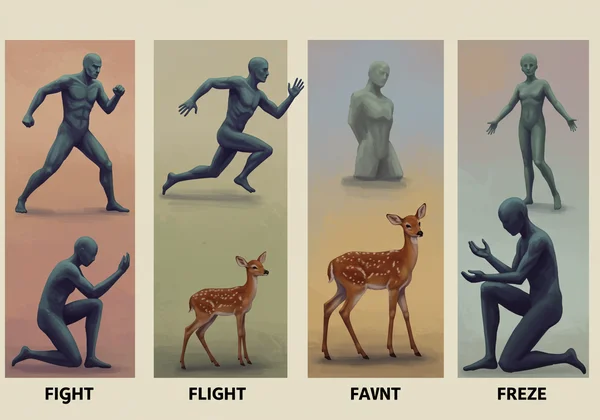Fawn Trauma Response: Understanding People-Pleasing with a Free Trauma Test
Do you find yourself constantly agreeing with others, even when you disagree? Is the thought of saying "no" filled with anxiety and guilt? If you often prioritize everyone else's needs and emotions above your own, you might be doing more than just being "nice." This pattern, often known as chronic people-pleasing, can be a deeply ingrained survival strategy known as the fawn trauma response. But how do I know if I have trauma? This article will explore the fawn response, helping you understand its origins, recognize its signs, and discover a path toward reclaiming your authentic self. For many, the first step is gaining clarity, and an initial self-assessment can provide valuable insights. You can begin your journey with a supportive first step.
Understanding the Fawn Trauma Response: A Survival Strategy
When we talk about responses to threats, we often hear about fight, flight, or freeze. However, there is a fourth, equally important response that often develops in response to relational trauma: fawning. This response involves immediately moving to appease a perceived threat to avoid conflict, criticism, or abandonment. It's a subconscious strategy to maintain safety by becoming helpful, agreeable, and attuned to the needs of others.

What is Fawning? Beyond Fight, Flight, Freeze
While fight, flight, and freeze are instinctual reactions to immediate physical danger, fawning is a more complex relational strategy. It’s a survival tactic learned when a person, often as a child, realizes that their safety depends on keeping a volatile or unpredictable caregiver happy. Instead of fighting back or running away, they learn to pacify the source of danger. This pattern involves suppressing personal feelings and needs to mirror the desires of the other person, effectively erasing oneself to prevent harm. If this feels familiar, a free trauma screening can help you explore these patterns in a safe, private way.
The Genesis of Fawning: Pete Walker's Insights on CPTSD
The concept of the fawn response was brought to the forefront by psychotherapist Pete Walker in his work on Complex PTSD (CPTSD). He identified fawning as one of the four primary trauma responses, particularly common in those who experienced prolonged childhood abuse, neglect, or narcissistic parenting. According to Walker, fawning is an attempt to find safety through connection, even if that connection is unhealthy. The child learns that their value and security are tied to their ability to serve and anticipate the needs of their caregivers, a pattern that persists into adulthood, shaping their relationships and sense of self.
Signs You Might Be Experiencing People-Pleasing Trauma
Recognizing the fawn response in yourself can be difficult because it's often disguised as kindness or generosity. However, people-pleasing rooted in trauma feels compulsive and comes at a great personal cost. It isn't a choice; it's a deeply programmed reaction.
Chronic Agreement and Fear of Conflict
A key sign of the fawn response is an intense fear of conflict. You might find yourself agreeing with opinions you don't share or apologizing for things that aren't your fault, all to maintain harmony. The idea of someone being upset with you can feel deeply threatening, triggering a need to immediately smooth things over. This isn't about compromise; it's about self-abandonment for the sake of perceived peace.
The Difficulty of Setting Healthy Boundaries
For someone with a fawn response, boundaries can feel dangerous. Saying "no," stating a different opinion, or prioritizing your own needs can feel like you are risking rejection or anger. You may over-commit, take on too much work, or stay in unhealthy relationships because the alternative—setting a boundary—feels impossible and unsafe. Understanding why this is so hard is a critical step toward change. You can explore your responses further on our platform.
Feeling Invisible, Resentful, and Exhausted
Constantly managing others' emotions is physically and emotionally draining. If you often find yourself fawning, you might feel invisible, as if your true self is hidden behind a mask of agreeableness. Over time, this can lead to a deep sense of resentment, burnout, and confusion about one's own identity. You might ask yourself, "What do I actually want?" and find no clear answer. This emotional exhaustion is a clear signal that your people-pleasing is a coping mechanism, not a choice.

Why We Fawn: The Roots of This Trauma Response
Understanding where the fawn response comes from is essential for healing. It is not a character flaw or a sign of weakness; it is a brilliant adaptation to an environment that felt unsafe. By recognizing its origins, you can begin to treat yourself with the compassion you so freely give to others.
Childhood Experiences and Survival Mechanisms
The fawn response is most often rooted in childhood. In homes with emotionally immature, neglectful, or abusive parents, a child's needs are often ignored or punished. To survive, the child learns to become hyper-vigilant to their caregivers' moods. They become an expert at anticipating what will please them or, at the very least, what will prevent an outburst of anger or withdrawal of affection. This survival skill becomes wired into their nervous system and carries over into adult relationships. If you suspect your past experiences are affecting you today, taking a confidential childhood trauma test can be an enlightening first step.

Navigating Abusive or Narcissistic Environments
Fawning is also a common response to being in a relationship with a narcissistic or abusive partner. In these dynamics, the abuser creates an environment where their needs are paramount and any dissent is met with punishment, be it emotional or physical. The fawn response becomes the only viable strategy to de-escalate conflict and survive the relationship. The person learns to walk on eggshells, constantly monitoring their partner's mood and catering to their every whim to maintain a fragile sense of safety.
Beginning Your Healing Journey: Moving Beyond the Fawn Response
Healing from the fawn trauma response is a journey of reclaiming your voice, your needs, and your sense of self. It involves learning that you are worthy of love and respect, not because of what you do for others, but simply because of who you are. This process takes time, patience, and a great deal of self-compassion.
Cultivating Self-Awareness: Recognizing Your Patterns
The first step is always awareness. Begin to notice when you feel the urge to people-please. What situations trigger it? What emotions come up when you consider saying "no"? Simply observing these patterns without judgment can reduce their power. A tool like a psychological trauma test can help you identify and label these patterns, providing a concrete starting point for your journey.
Gentle Steps Towards Setting Boundaries
Learning to set boundaries is a skill that can be developed slowly. Start small. Say "no" to a minor request or state a simple preference, like choosing which movie to watch. Practice saying, "Let me think about it," instead of giving an immediate "yes." Each small step builds confidence and retrains your nervous system to understand that setting boundaries does not mean you will be abandoned or punished.
When to Seek Professional Support for Trauma
While self-help strategies are valuable, healing from deep-seated trauma often requires professional guidance. A trauma-informed therapist can provide a safe space to explore the roots of your fawn response, process painful memories, and develop healthy coping mechanisms. They can help you build self-esteem and learn how to form secure, authentic relationships. Recognizing you need help is a sign of strength, not weakness.
Reclaiming Your Authentic Self: A Path Beyond Fawning
The fawn response is a testament to your resilience and your incredible ability to adapt and survive. But you no longer have to live in survival mode. Healing is about moving from merely surviving to truly thriving. It’s about learning that your voice matters, your needs are valid, and you are worthy of taking up space in the world.

Understanding your trauma responses is a profound act of self-care. It's the beginning of a journey back to yourself. If this article resonated with you, consider taking the next step. Visit our homepage to take a free, confidential online trauma test. It’s a gentle, non-judgmental way to gain deeper insight into your experiences and start your path toward healing.
Frequently Asked Questions About the Fawn Response & Trauma
Is people-pleasing always a sign of trauma?
Not necessarily. Kindness, empathy, and a desire to help others are positive human traits. The difference lies in the motivation and feeling behind the action. Healthy generosity feels good and is a choice. Fawning, on the other hand, feels compulsive, is driven by fear, and often leads to resentment and exhaustion because your own needs are consistently ignored.
Can the fawn response be healed?
Absolutely. Healing is a process of learning to feel safe in your own body, building self-worth, and developing the skill of setting healthy boundaries. With self-awareness, compassion, and often the support of a trauma-informed therapist, you can unlearn these patterns and build more authentic and fulfilling relationships.
How can I tell which trauma response I use most?
Most people have a dominant trauma response but may use others depending on the situation. Reflecting on how you typically react under stress can offer clues. Do you tend to appease others (fawn), become confrontational (fight), withdraw (flight), or shut down (freeze)? An assessment tool can help clarify your patterns. The trauma response test on our site is designed to provide these initial insights.
Where can I get an accurate trauma test to understand my responses?
While no online tool can provide a formal diagnosis, a well-designed screening can be a powerful first step in understanding your symptoms. On our platform, we offer a free, confidential, and science-informed trauma test for both kids and adults to help you identify potential trauma symptoms and gain clarity on your emotional health.